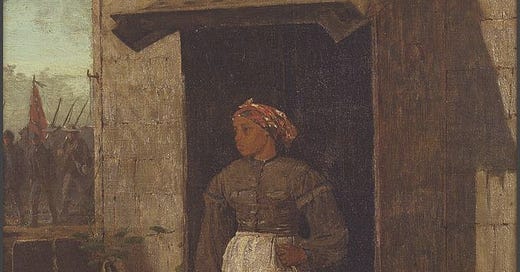Review. Peter H. Wood. Near Andersonville. Winslow Homer's Civil War. Cambridge, MA: Harvard University Press, 2010.
What's the point of being a respected historian if you're going to write like an art historian and spoil it all? The whole of Wood’s argument rests on two back-to-back pronouncements in the conclusion to this very short book, 88 pages of text plus 33 pages of notes:
[Winslow] “Homer, after all, was not some talented trickster, cleverly posing visual riddles for his contemporary audience. [He was] an insightful humanist whose work would endure." [p. 82]
Immanuel Kant argued that you can’t resolve problems of interpretation by shifting them onto an individualist psychology. Homer may or may not have been an “insightful humanist,” and I’d certainly want his work to endure, but it’s hard to see the connection between the first and second assertion, the more so as the author’s just spent the last third of the book suggesting that Homer was indeed “cleverly posing visual riddles” for his audience — and incidentally, for us. In fact, the author’s just suggested that a number of these riddles have a greater application today than in 1866, when Homer painted Near Andersonville, the canvas which is the subject of this study.
Those last pages are a curious art-historical letdown after the preceding two-thirds, which make for fascinating and informative reading on the painting, its provenance and historical context. Near Andersonville was painted at the end of the American Civil War; its subject is a failed Union attempt to liberate the Confederate prisoner-of-war camp at Andersonville. The painting’s “perceiving subject,” as Kant might have called her, is a Black servant observing, impassive, from a porch as captured Union troops are marched on. The painting was rediscovered in a private collection in 1960, its full title only in 1987. One could argue that the full meaning had to wait for Wood’s little book.
“How did this same work appear to its initial audience?” [p. 19] And who was this initial audience to begin with? The author does better at answering the second question than the first. In 1987 it emerged that the first likely owner of this painting was one Sarah Louise Kellogg, a fervent abolitionist who had spent the War years on the staff of a school for Blacks on a sea island liberated from the Confederacy. A painting like this one, showing a Black woman as a full, thoughtful human being, would have considerable appeal for Kellogg; the artist himself might be expected to have brought a similar sensitivity to the topic, and Wood skillfully lays out the case for Homer’s own sensitivity, rooted in his Boston abolitionist background.
It's when Wood attempts to go further that his argument breaks down. The late Linda Nochlin used to tell how she once taught at some elite university — not Duke, where Wood is Professor Emeritus, but Princeton. You show a slide of a painting of a tree in your seminar, she said, and next week every student will turn up with every piece of possible information about trees: types of trees, trees in Art, lumberyards. This procedure is indicative of the lack of methodological rigor that bedevils art historians and curators.
In the days when I taught Medieval Art I would occasionally stand in front of the classroom with a piece of chalk in hand and explain why the chalk is there to remind us of the Transfiguration of Our Lord Jesus Christ and why, if we all follow the lessons of this humble piece or chalk we, too may attain Salvation. Most students got the joke. Wood, likewise, proceeds to catalogue the various items and ascribed attitudes in Near Andersonville according to the meanings that might possibly have been imputed to them anywhere, any time. The image of a gourd occupying a few inches of canvas is there to remind us of the “Drinking Gourd” that escaped slaves were to follow to freedom. Also, banjos are made from gourds; also, “gourds are a long-standing emblem of fertility.” [pp. 77-79] Also, the word “gourde” in French means a clumsy dolt. Notice the red-white-and-blue in the woman’s headdress. Coincidence?
In the end, the most telling passage in this book is a brief quote from a New York daily for April 19, 1866, announcing a “Sale of Pictures” that was to feature Near Andersonville: “The Evening Post observed that this particular image was ‘full of significance.’” [p. 29] But signifying what? And to whom? If authority to interpret this painting is to be placed, as Hood justifiably suggests, in its rightful audience (those who understand the true meaning of gourds, not to mention banjos), then what of Homer, the “insightful humanist whose work would endure?” Supposing you accept that the meanings inherent to Homer’s paintings are accessible only to a Black audience, and a Black audience of a certain type, though I’m not sure how many African Americans today would relish the banjo reference? After that you can’t go claiming some kind of universal meaning ensconced in the mind of Homer as of God, unless you happen to believe God, too, is a humanist, and that’s a proposition that flies in the face of out own lived experience, as it goes against the evidence of Homer’s paintings. Homer himself was half amused, half disgusted, one suspects, by this fantasy of an artist strewing meanings all over his canvas like God strewing the stars across the heavens. Like a lesser god he knew his own frailty. Or like a woman standing in a doorway, watching the prisoners pass.
June 28, 2022




